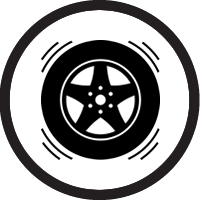
Don’t let a vibration ruin your day. Wheel vibration is an unpleasant condition that can lead to premature tire wear or costly mechanical failures of the steering and suspension components.
An experienced technician will do a visual inspection first to determine if any wheels are loose. If all the wheels are tight, then a road test will help to pinpoint the cause of the vibration.
The reason for the vibration could be as simple as a missing wheel weight, putting the wheel into an out-of-balance condition. Keep in mind that winter driving conditions can cause snow and ice to build up on the inside portion of the rim causing extreme vibrations. This snow and ice need to be removed to avoid damaging your vehicle.
Leave balancing the wheels to the professionals; they will assure that the rim is cleaned of any snow, ice, mud, rust or other debris that could hinder a vibration free balance.
Wheel vibrations increase the likelihood of damaging the steering and suspension components of the vehicle. Certain materials present in these components, such the nylon used to cushion the swivel point of ball joints and tie rod ends will experience extreme pressure when the wheel or wheels are out-of-balance.
Not only do you risk damaging the steering and suspension components of the vehicle but the tire will wear at a rapid rate due to the constant “hopping” on the pavement.
At the end of the day, an unbalanced wheel is not good for the driver, passengers or the vehicle. Keep in mind that there are several different types of wheel balancers in the market; the best shops have modern equipment that can pinpoint problems with infrared laser technology and diagnostic capabilities.
Tire balance is the action of correcting the balance of the tire and wheel assembly. The tire and wheel are placed onto a wheel balancing machine to determine if any weights (stick on, clip on or press on) are required to bring the assembly back to a balanced state. This practice is common in the industry and accepted as a general method of vibration control.
However; these types of wheel balancers are limited to what kind of diagnosis they can provide to eliminate vibrations. If a wheel assembly has excessive lateral run-out (side to side movement while rotating) adding weight will not correct the balance but may mask the concern. When spinning the wheel assembly on the balancing machine, an experienced installer can detect both lateral and radial run out and recommend a further inspection.
In some cases, a wheel assembly (tire and wheel) may contribute to the vibration condition. A term referred to as “lateral run-out”, which is the wheels side to side movement about its spin axis can cause the wheel assembly to move back and forth disrupting the natural rotation of the assembly. This uncommon occurrence can be perceived as a vibration by the driver.
Another industry term is known as “radial run-out” is a condition where the wheel assembly moves in an eccentric pattern around its spin axis. Picture an egg trying to roll down the street, the up and down motion creates vibration and excessive movement. The same principal applies to the vehicle.
The tread surface of the tire may experience a deformity caused by wheel lock up to flat spotting from parking overnight. Advancements in tire balancing machine technology can now depict the difference in wheel lock up flat spotting or overnight parking flat spotting. No other equipment in the marketplace can perform these same functions. As an added precaution to eliminate vibration concerns, some equipment manufacturers recommend taking the vehicle for a “warm up” drive before doing the actual wheel balance.
For a vibration to exist, there must be an abnormality in the drive-line. This disturbance must be significant enough to be experienced by the driver. A vibration is a result of one of the following: incorrectly balanced wheel assembly, a bent rim, radial run-out, lateral run-out, and a build-up of mud or snow inside the rim, improper inflation or a mechanical failure such as a defective wheel bearing or axle shaft. For the safety of the driver and passengers always refer to the vehicle manufacturers placard, usually located on the driver’s side door pillar, for the correct tire inflation pressure.
Rotating your tires is an essential part of the regular maintenance to your vehicle. The purpose of rotating the tires is to achieve a more uniform wear for all of your tires saving you money in the long run. Refer to your owner’s manual for the recommended interval to rotate the tires. If this is not available, vehicle manufacturers recommend that you use the same interval as changing the oil and filter (every 7,500 miles or 12,000km or 6 months whichever occurs first) to rotate your tires. The more you pay attention to tire rotation and tire inflation the longer the tires will last.
View More Advice